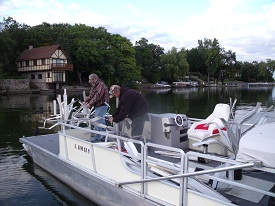Nov. 21–The first stage of a habitat makeover for Dry Creek coho salmon and steelhead is one step closer to construction.
Sonoma County officials will unveil plans next summer to install side channels, boulders and logs to offer greater shelter for the endangered and threatened fish.
The work is part of a 2008 federal order to improve conditions for the two species in the Russian River watershed. On Dry Creek, which the county uses to deliver water for 600,000 customers but where fish are in need of more slow-water habitat, the efforts would cover six of the stream’s 14 miles and cost $36 to $48 million.
County supervisors last week approved the first phase of that project, on a one-mile stretch of the stream bisected by Lambert Bridge Road.
Eleven landowners in the area are working with the county to provide access to the creek for construction and future maintenance and repair. Total building cost is estimated at $6 million to $8 million, with an additional $413,000 for the purchase of short- and long-term easements.
County officials hope the work, including collaboration with an initial group of landowners, will lay the foundation for the rest of the project, which would run through 2020 if the early stages are successful.
The alternative is a costlier $150 million to $200 million fix that would lower flows in the creek through a parallel water pipeline running from Lake Sonoma to Healdsburg.
“To say the success of the first mile (of habitat improvement) is critical to the entire project is an understatement,” said Supervisor Mike McGuire, who represents the area. “Failure is not an option.”
Construction is set to begin in June and run through October, taking advantage of the dry season.
Excavators will carve out four channels off the main creek for backwater habitat, while workers in other areas embed boulder clusters and about 2,000 logs in the stream to slow water and provide holding pockets for fish.
See the dozens of unique artificial fish habitat models, fish attractors and fish cover used at fishiding.com, the industry leader and only science based, man made and artificial fish habitat, proven to provide all fish with cover they prefer to prosper.
Non-native plants will also be removed and native bushes and trees installed.
The goal is about 114,000 square feet of improved habitat, said David Manning, principal environmental specialist for the county Water Agency, which is overseeing the project.
One grape grower participating in the project said the efforts were part of a renewed focus on fish-friendly farming in the area.
“We’re looking forward to working with the agency on Dry Creek projects now and in the future,” said Ned Horton, vineyard manager at Quivira Vineyards and Winery.
By Brett Wilkison, The Press Democrat, Santa Rosa, Calif.

